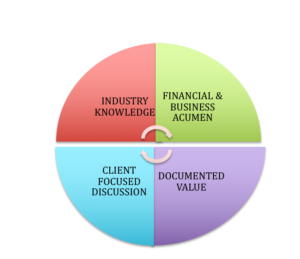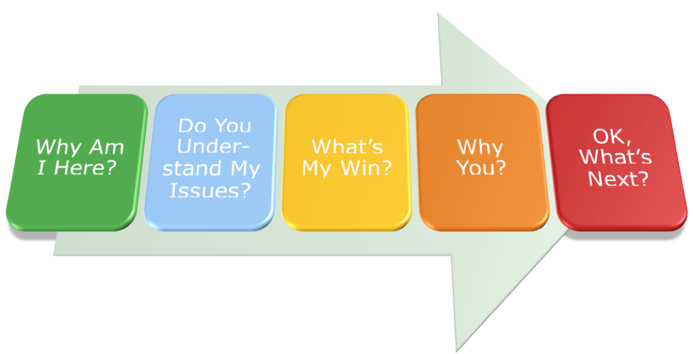There is an abundance of excellent articles on selling to the C-suite or the executive management team. It’s strong evidence of the continued professional growth of our global sales community. You can find data-driven supportive research documents, testimonials and interviews, books and case studies. It’s a topic that creates a high degree of interest in most sectors of the global marketplace—especially healthcare–and within all levels of the sales community.
However, when it comes to professional development, our appetite is more suited to “bite-size” morsels rather than the full cafeteria of literary options. So we thought it might be useful, and for the sake of brevity, to distill some of the research, interviews, books, and articles into several pages of our summary observations. While we claim no mastery of the material, we have been avid observers, readers and contributors in the specialty area of high-end professional sales. The following issues can serve as our guide through the spectrum of material on this topic:
- Why is it necessary for many of us in healthcare who have sold successfully at a lower level in our customer’s organization to now connect with the executive team?
- How is an executive level conversation or sales call different from more traditional mid-level sales calls?
- What are the keys to the executive mindset and what questions must you prepare to answer?
Why is it necessary to connect with the executive team?
The answer lies in three observations. For those of you selling in various segments of healthcare, you may judge for yourselves, the applicability to your specific market.
- Healthcare organizations are redefining their buying processes in order to drive out unnecessary cost. They are centralizing decision making authority at a high level, often relegating the role of strategic procurement to the C-suite level.
- Healthcare organizations are relying more on consensus-driven value assessment committees for product comparisons. Many of these committees are staffed by, and have a direct reporting responsibility to, the CFO.
Due to the sheer volume of purchasing requirements, committees now look to their executive sponsors for guidance in prioritizing projects and to develop a decision tree analysis based on the needs/demands of the facility and/or healthcare system.
How is an executive level conversation different from more traditional mid-level calls?
While there are many differences, it essentially boils down to research, access, understanding and value.
- The C-Suite executive will expect you to be well researched and understand fully the problem or project from his/her perspective.
- Most healthcare executives have very little time to waste on projects that don’t promise to deliver a measurable return to the organization. Research has shown that of all the sales representatives who gain an initial conversation at the executive level only 7% gain a second conversation. It gives “one and done” a whole new meaning.
- Since executives have an organization-wide perspective, they expect you to understand and comprehend how they measure value. The metrics that appeal to a senior executive may be significantly different from how a mid-level manager, department head or clinical practitioner perceives value.
What is the “executive mindset” and what questions must you prepare to answer?
Let’s tackle mindset first by rephrasing the question slightly. What is the senior executive expecting you to evidence in your conversation or sales call? Executives are hopeful you will bring to the discussion (at minimum) four key contributions: industry knowledge, financial and business acumen, documented value in your solution and a rich discussion that focuses on resolving their issues, challenges or needs.
 If you want to connect at the executive level (and successfully enhance your prospects of winning new sales opportunities) you’ll need to elevate your game. You will want to scorecard yourself in each of these critical areas and ask yourself, “What do I need to demonstrate in my executive discussion to validate my industry competency?” “What financial and/or business issues are likely to be “top of mind” to my customer and what specific metrics will I positively impact?” “How can I document value and not just compare products?” “How can I become an “active listener” during our conversation so that I demonstrate a laser-like focus on my customer’s issues and priorities?”
If you want to connect at the executive level (and successfully enhance your prospects of winning new sales opportunities) you’ll need to elevate your game. You will want to scorecard yourself in each of these critical areas and ask yourself, “What do I need to demonstrate in my executive discussion to validate my industry competency?” “What financial and/or business issues are likely to be “top of mind” to my customer and what specific metrics will I positively impact?” “How can I document value and not just compare products?” “How can I become an “active listener” during our conversation so that I demonstrate a laser-like focus on my customer’s issues and priorities?”
Let’s consider the five questions that are running through an executive’s mind during your conversation.

Give some thought to crafting a powerful statement of focus that answers the question “Why is this executive investing precious time meeting with me?”
With your knowledge of their challenges or obstacles— along with an acute awareness of current market forces impacting your customer’s business–how will you demonstrate your competency?
How will you focus on their business benefit and document real value? And, in a related question, how does the value of your solution differentiate your proposal from your competition?
Last, what step(s) must your customer take to realize the full benefits promised in your proposal? If you can’t get your customer to move the buying process forward, everything you thought you accomplished will be at risk. Also, remember that planned action by both parties provides an excellent platform for advancing the initiatives.
Parting Thoughts
Many years ago, one of our customers had a prophetic quote on his desk. It was simple and compelling: “Action conquers fear.” Use executive conversations as tools for building your business case and mastering the opportunity. When the possibility or need emerges, evaluate the benefit of a C-suite conversation. When you find yourself unsure or fearful of a failed opportunity, take action and research your customer and be fully prepared.


